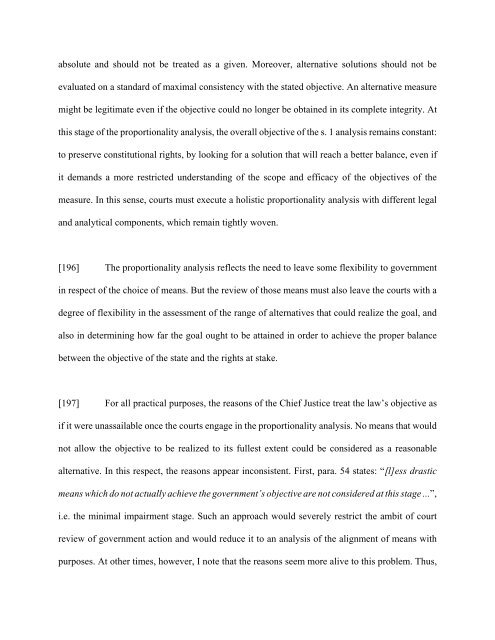SUPREME COURT OF CANADA CITATION: Alberta v. Hutterian ...
SUPREME COURT OF CANADA CITATION: Alberta v. Hutterian ...
SUPREME COURT OF CANADA CITATION: Alberta v. Hutterian ...
You also want an ePaper? Increase the reach of your titles
YUMPU automatically turns print PDFs into web optimized ePapers that Google loves.
absolute and should not be treated as a given. Moreover, alternative solutions should not beevaluated on a standard of maximal consistency with the stated objective. An alternative measuremight be legitimate even if the objective could no longer be obtained in its complete integrity. Atthis stage of the proportionality analysis, the overall objective of the s. 1 analysis remains constant:to preserve constitutional rights, by looking for a solution that will reach a better balance, even ifit demands a more restricted understanding of the scope and efficacy of the objectives of themeasure. In this sense, courts must execute a holistic proportionality analysis with different legaland analytical components, which remain tightly woven.[196] The proportionality analysis reflects the need to leave some flexibility to governmentin respect of the choice of means. But the review of those means must also leave the courts with adegree of flexibility in the assessment of the range of alternatives that could realize the goal, andalso in determining how far the goal ought to be attained in order to achieve the proper balancebetween the objective of the state and the rights at stake.[197] For all practical purposes, the reasons of the Chief Justice treat the law’s objective asif it were unassailable once the courts engage in the proportionality analysis. No means that wouldnot allow the objective to be realized to its fullest extent could be considered as a reasonablealternative. In this respect, the reasons appear inconsistent. First, para. 54 states: “[l]ess drasticmeans which do not actually achieve the government’s objective are not considered at this stage ...”,i.e. the minimal impairment stage. Such an approach would severely restrict the ambit of courtreview of government action and would reduce it to an analysis of the alignment of means withpurposes. At other times, however, I note that the reasons seem more alive to this problem. Thus,
















